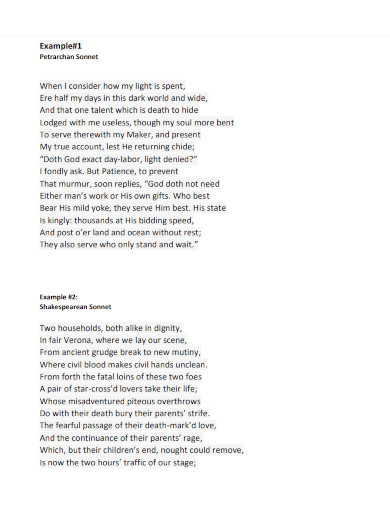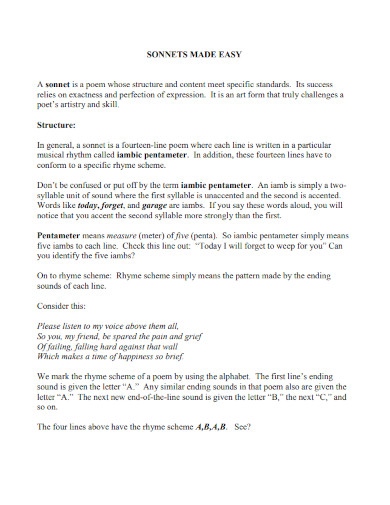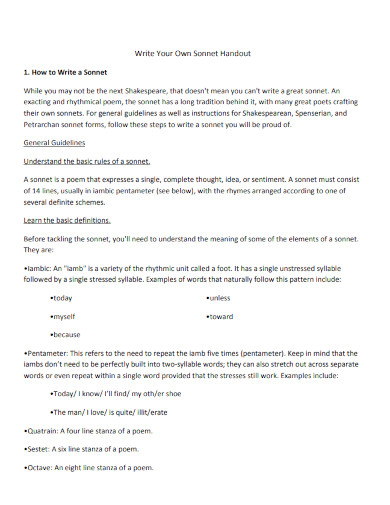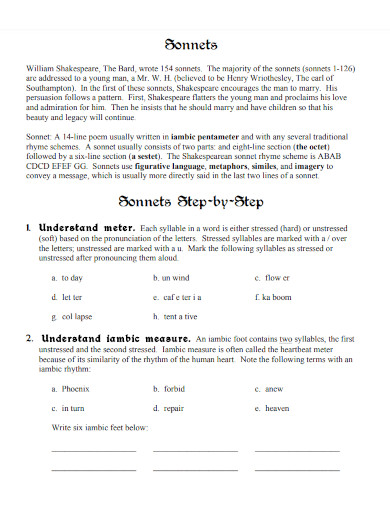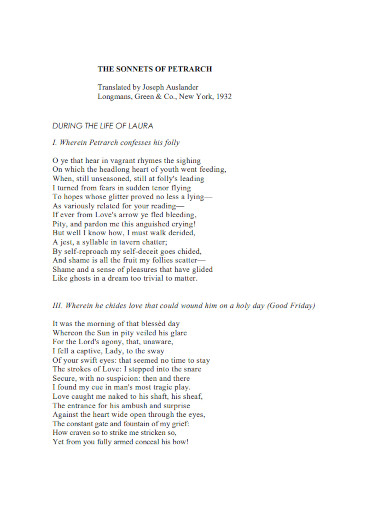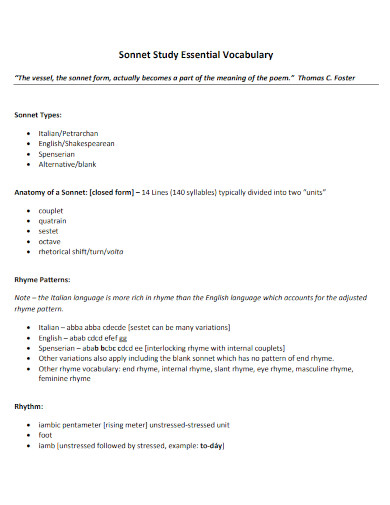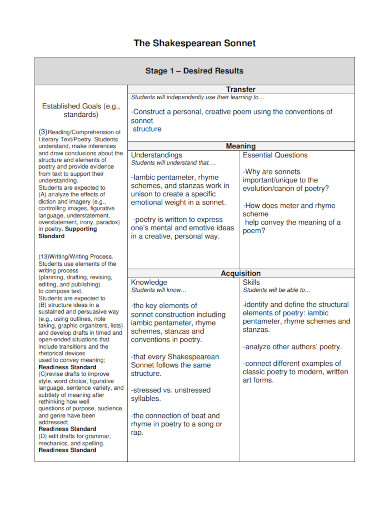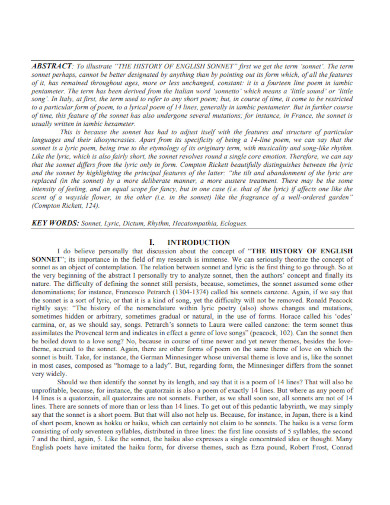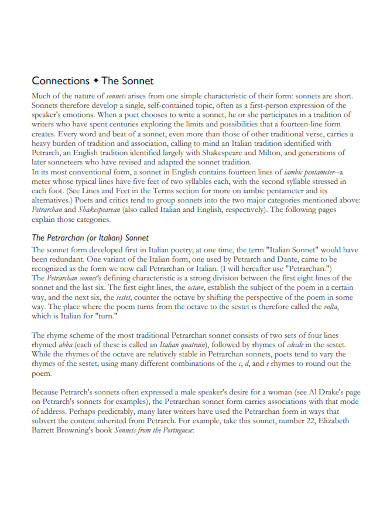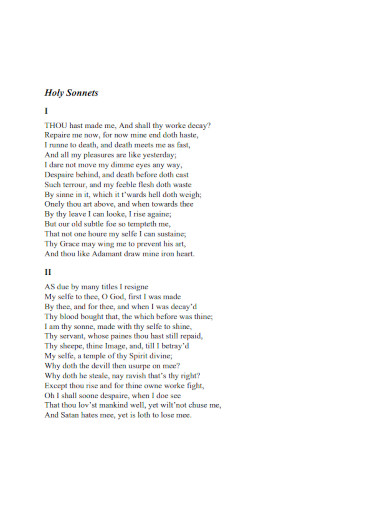11+ Sonnet Examples
There are many ways to create a poem that can generate a large amount of emotional impact on the target audience. One of the best poetic structures a person can adopt in their poetry is called a sonnet.
1. Sonnet Example
2. Sonnets Made Easy Template
3. Shakespeare’s Sonnets
4. Write Own Sonnet Handout
5. Sonnets Step-by-Step
6. Sonnets of Petrarch
7. Sonnet Study Essential Vocabulary
8. Shakespearean Sonnet
9. History of English Sonnet
10. Connections Sonnet
11. Holy Sonnets Template
What Is a Sonnet
A sonnet is a subtype of a poem that is characterized by the poem’s incorporation of the iambic pentameter structure and a rhyme scheme. Sonnets or Petrarchan have a deep historical origin that can be traced back to the thirteenth century.
How to Write a Sonnet
A sonnet is an effective way to create a poem that will stand out from the rest. If you need to have a reference when you write your sonnet, you may use any of the sonnet examples and a sonnet step-by-step guide on the links above.
Step 1: Select a Theme and Focus for the Sonnet
Begin by selecting the main theme and focus of the sonnet. This will provide you with the direction you can use to write your sonnet. Not only that but this will allow you to have access to specific words and phrases that are associated with the selected focus and theme of the sonnet.
Step 2: Outline The Lines of the Sonnet
The sonnet follows an iambic pentameter structure alongside a rhyme scheme, this means that there are eleven lines on the sonnet with rhymes at the end of each line. You must outline all the lines to help create a sound structure and ensure that each line has ten syllables, whilst adhering to the rhyme scheme.
Step 3: Incorporate Various Literary Devices
One of the best ways you can write an effective sonnet is through the use of various literary devices. By incorporating said literary devices like similes and metaphors, you can improve the overall quality and impact of your sonnet.
Step 4: Write the Sonnet
When you have finished planning the contents of your sonnet, you must now write said sonnet out. Be sure that the contents of your sonnet will have eleven lines, with the iambic pentameter structure and rhyme scheme.
FAQs
What makes a poem a sonnet?
A sonnet is denoted by a specific unique element that makes it stand out from other types of poems. A poem will be considered a traditional sonnet when the poet has created fourteen lines with a rhythm of ten syllables each line with a specific pattern of the stressed syllable. This rhythm acts as a literary device which is called an iambic pentameter, which the poem modifies with a rhyming structure. When a poem adopts this specific structure, said poem will be considered a sonnet.
Why is it called a sonnet?
A sonnet is a poem structure that a lot of people have been using globally. The origin of the word sonnet comes from the Italian word “Sonetto” which means a “little song or sound”. This Italian word primarily describes how a sonnet would usually sound when a person recites a sonnet out loud. Not only does the word sonnet have an Italian root word, but sonnets were first created in Italy during the 13th century, usually adopting the theme of romance and love. This style of poetry was popularized and widely used in the 16th century by British poets.
Is a sonnet a love poem?
The main focus and theme of sonnets are primarily centered around the idea of romance and romantic love. This is because sonnets in the past have perpetuated this theme or idea. Because of this, sonnets are primarily centered around the romantic context. Examples of sonnets used as love poems are named Shakespeare’s Sonnet 18 “Shall I Compare thee to a Summer Day”, and Sonnet 116 “Let me not to the marriage of true minds”. But this doesn’t mean sonnets have to talk about romance and love. Modern-day sonnets often range from various topics like worship, death, grief, etc. Examples of modern-day sonnets that don’t deal with love or romance are Immortality by Claire Harner, and Ozymandias by Percy Shelly. In conclusion, not all sonnets are love poems, as some sonnets deal with various topics and concepts.
A sonnet is a type of poetic structure that is characterized by its unique elements and poetic structure. A well-written sonnet is very memorable and can create an emotional impact on the reader. Therefore, a sonnet is an effective way to template and create a deep emotional poem that can affect and touch its intended target audience.



